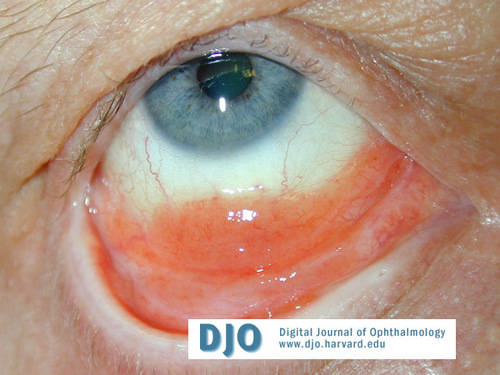Orbit/Oculoplastics Quiz 11

Inferonasal conjuctival lesion
Answer: The photograph shows a pink raised conjunctival lesion with an appearance that is most consistent with conjunctival lymphoma.
2. What are the characteristic clinical features of this condition?
Answer: Conjuctival lymphoma presents as a diffuse, slightly elevated pink mass located in the stroma or deep to Tenon's fascia. The lesion often has a color similar to salmon, hence the term “salmon patch”. These lesions are fleshy and often originate the fornix or adjacent to the limbus. The patient population usually includes young to middle aged adults and the presenting sign is usually chronic redness
3. What is the differential diagnosis of this condition?
Answer: The differential diagnosis includes all other causes of chronic focal eye redness, including autoimmune diseases (scleritis and episcleritis), ectopic lacrimal gland, amyloid deposition, foreign body, and other ocular surface tumors, both benign (squamous papilloma, pyogenic granuloma, lymphagiectasias) or malignant (squamous carcinoma, amelanotic melanoma).
4. How is the diagnosis established?
Answer: The diagnosis of lymphoma is established via biopsy of the lesion that reveals the distinct morphologic, immunologic, cytogenetic and molecular characteristics of the invading tumor cells. Under the light microscope, lymphoproliferative lesions may reveal a continuum from benign reactive lymphoid hyperplasia to malignant lymphoma. Immunological surface marker identification can classify tumors as containing B or T cells and molecular biology techniques can differentiate between monoclonal and polyclonal proliferations. Lymphomas are generally divided into 2 categories that have prognostic significance: MALT (mucosal associalted lymphoid tissue) and non-MALT lymphomas. About 60% of lymphoid proliferation of the conjunctiva are monoclonal B-cell lymphomas of the MALT low-grade variety (favorable prognosis) whereas primary conjunctival T-cell lymphoma or Hodgkin's disease is extremely rare.
5. What is the additional work-up required for this condition?
Answer: Patients should have a complete medical check up (including CBC and differential), radiologic imagining of the head, neck and abdomen (staging) and be followed by a hematologist- oncologist to determine whether the lymphoma is limited to the conjunctiva or is more wide-spread throughout the body. Because of occasional late manifestations of extra-ocular lymphoma (up to 53 months after the diagnosis), systemic evaluation should be repeated every 6 months after conjunctival lymphoma is diagnosed.
6. What are the course of this condition?
Answer: Conjuctival lymphoma is usually localized only, but can represent a sign of systemic lymphoma. The ocular lesions are not considered the nidus of disease when concurrent systemic lymphoma is present. The MALT lymphomas (mucosa- associated lymphoid tissue lymphoma) are less aggressive whereas the non-MALT are considered highly malignant and invasive. The five-year survival rate for MALT lymphomas is excellent and reported to be 93%. Clinical outcome differs according to staging and anatomic manifestation of lymphoma, whereas the presence of systemic disease carries a worse prognosis.
7. What are the treatment options?
Answer: Treatment options depend on the presence of systemic disease. If the conjuctival lesion is the only site of the disease (no systemic or other ocular involvement) treatment options include observation or external beam radiation therapy (2000-4000 cGy). Conjunctival lymphoma may regress spontaneously and is not thought to spread sytemically. Observation alone may be considered for isolated lesions, while radiation may be considered for symptomatic lesions, especially if they threaten vision and are not resectable. Dosage and exposure tends to be higher for more aggressive non-MALT lymphomas, though care must be taken to minimize long-term complications of ocular radiation such as xerophthalmia, keratitis or cataract formation. Recent studies have shown that local antibiotic therapy and intralesional interferon may also be a viable form of therapy for MALT lymphomas of the conjunctiva, but further study of these potentisl treatments is warranted.
Chemotherapy should be considered only in the few patients presenting with aggressive histological subtypes or for those with systemic lymphoma.
Shields CL, Shields JA, Carvalho C, et al. Conjunctival lymphoid tumors: clinical analysis of 117 cases and relationship to systemic lymphoma. Ophthalmology 2001; 108(5):979-84.
Jakobiec FA, Knowles DM. An overview of ocular adnexal lymphoid tumors. Trans Am Ophthalmol Soc 1989; 88:420-42; discussion 442-4.
Bessell EM, Henk JM, Whitelocke RA, et al. Ocular morbidity after radiotherapy of orbital and conjunctival lymphoma. Eye 1987; 1 (Pt 1):90-6.
Zucca E, Conconi A, Roggero E, et al. Non-gastric MALT lymphomas: a survey of 369 European patients. The International Extranodal Lymphoma Study Group. Ann Oncol 2000;11, Suppl 4:99
Jenkins C, Rose GE, Bunce C, Cree I, Norton A, Plowman PN, Moseley I, Wright JE Clinical features associated with survival of patients with lymphoma of the ocular adnexa Eye 2003, 17, 809-820.
Chang YC, Chang CH, Liu YT, Tsai KB, Liu TC, Lin YN. Spontaneous regression of a large-cell lymphoma in the conjunctiva and orbit. Ophthal Plast Reconstr Surg. 2004 Nov;20(6):461-3.
Matsuo T, Yoshino T. Long-term follow-up results of observation or radiation for conjunctival malignant lymphoma. Ophthalmology. 2004 Jun;111(6):1233-7.